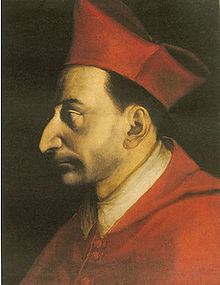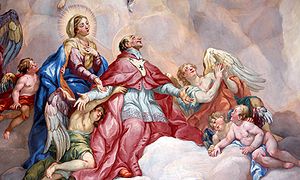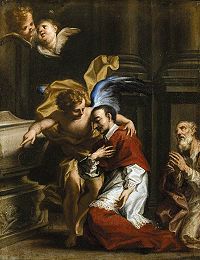- Charles Borromeo
-
Saint Charles Borromeo Cardinal Archbishop of Milan 
Carlo Borromeo, by Giovanni Figino. Oil on canvas, 41 × 48 cm. Biblioteca AmbrosianaChurch Catholic Church See Milan Enthroned 12 May 1564 Reign ended 3 November 1584 Predecessor Filippo II Archinti Successor Gaspare Visconti Orders Ordination 4 September 1563 Consecration 7 December 1563
by Giovanni SerbelloniCreated Cardinal 31 January 1560 Rank Cardinal-Priest of Santa Prassede Personal details Birth name Count Charles Borromeo di Arona Born 2 October 1538
Castle of Arona, Duchy of MilanDied 3 November 1584 (aged 46)
MilanBuried Milan Cathedral Parents Gilberto Borromeo, 7th Count of Arona
Margherita de' Medici di MarignanoSainthood Feast day November 4 Venerated in Catholic Church Beatified 12 May 1602
by Pope Paul VCanonized 1 November 1610
by Pope Paul VAttributes cord, red cardinal robes Patronage against ulcers; apple orchards; bishops; catechists; catechumens; colic; intestinal disorders; Lombardy, Italy; Monterey California; seminarians; spiritual directors; spiritual leaders; starch makers; stomach diseases; São Carlos city in Brazil (as the name indicates) Shrines Milan Cathedral Charles Borromeo (Italian: Carlo Borromeo, Latin: Carolus Borromeus, 1538–1584) was the cardinal archbishop of the Catholic Archdiocese of Milan from 1564 to 1584. He was a leading figure during the Counter-Reformation and was responsible for significant reforms in the Catholic Church, including the founding of seminaries for the education of priests. He is honoured as a saint in the Catholic Church and his feast day is November 4.
Contents
Early life
The son of Gilberto II Borromeo, conte (count) of Arona, and Margherita de' Medici (sister of Pope Pius IV), Carlo Borromeo was born on 2 October 1538 at the castle of Arona on the shores of Lago Maggiore in northern Italy. The aristocratic Borromeo family's coat of arms included the Borromean rings, sometimes taken to symbolize the Holy Trinity.
When Borromeo was about twelve years old, his uncle Giulio Cesare Borromeo, resigned to him an abbacy (the office and dignity of an abbot). Borromeo applied the revenue from this position in charity to the poor. He studied the civil and canon law at Pavia. In 1554 his father died, and although he had an elder brother, Count Federigo, he was requested by the family to take the management of their domestic affairs. After a time, he resumed his studies, and in 1559 he took his doctoral degree. In 1560 his uncle, Cardinal Angelo de' Medici, was raised to the pontificate as Pope Pius IV.
Pius IV named Borromeo as protonotary apostolic (secretary of state), entrusted with both the public and the privy seal of the ecclesiastical state. He then named Borromeo to the post of Cardinal of Romagna and the March of Ancona, and supervisor of the Franciscans, Carmelites and Knights of Malta.
Archbishop of Milan
At age twenty-two, Borromeo was highly trusted at the papal court. Soon afterwards Pius IV raised him to the archbishopric of Milan. In compliance with the pope's desire, Borromeo lived in splendor to represent the glory of the church. He established an academy of learned persons, the Academy of the Vatican Nights, and published their memoirs as the Noctes Vaticanae.
About the same time, Borromeo founded and endowed a college at Pavia, today known as Almo Collegio Borromeo, which he dedicated to Saint Justina of Padua. On the death of his elder brother Federigo, his family urged Borromeo to quit the church to marry and have children, so that the family name would not become extinct.
Borromeo declined the proposal. He worked even harder for the welfare of the church. Owing to his influence over Pius IV, he facilitated the final deliberations of the Council of Trent. He took a large share in the creation of the Tridentine Catechism (Catechismus Romanus).
Reform Program (Acta Ecclesiae Mediolanersis)
After the death of his uncle, Pius IV (1566), Borromeo contributed materially to suppressing the cabals of the conclave. Subsequently he devoted himself wholly to the reformation of his diocese. It had deteriorated in practice owing to the 80-year absence of previous archbishops.[1] Borromeo made numerous pastoral visits, and restored dignity to divine service.
In conformity with the decrees of the Council of Trent, which suggested simplifying church interiors, Borromeo cleared the cathedral of ornate tombs, rich ornaments, banners, and arms. He did not even spare the monuments of his own relatives. He divided the nave of the church into two compartments to separate the sexes at worship.
He extended his reforms to the collegiate churches, monasteries and even to the Confraternities of Penitents, particularly that of St. John the Baptist. This group was to attend to prisoners and those condemned to death, to give them help and support.
Borromeo believed that abuses in the church arose from clergy ignorance. Among his most important actions, he established seminaries, colleges and communities for the education of candidates for holy orders. His emphasis on Catholic learning greatly increased the preparation of men for priesthood and benefited their congregations.
In addition, Borromeo founded the fraternity of Oblates of St. Ambrose, a society of secular men who did not take orders, but devoted themselves to the church and followed a discipline of monastic prayers and study. They provided assistance to parishes where ordered by the church.[1]
Suppression of witchcraft and heresy
Though the Diet of Ilanz of 1524 and 1526 had proclaimed freedom of worship in the Republic of the Three Leagues, Saint Charles repressed Protestantism in the Swiss valleys. The Catholic Encyclopedia relates: “In November [1583] he began a visitation as Apostolic visitor of all the cantons of Switzerland and the Grisons, leaving the affairs of his diocese in the hands of Monsignor Owen Lewis, his vicar-general. He began in the Mesoleina Valley; here not only was there heresy to be fought, but also witchcraft and sorcery, and at Roveredo it was discovered that the provost, or rector, was the foremost in sorceries.” [2] During his pastoral visit to the region, the Cardinal had about a hundred people arrested for practicing witchcraft. Ten women and the provost were condemned to “the flaming death”. They were put to death by being placed head-first in the fire.[3]
Reacting to the pressure of the Protestant Reformation, Borromeo encouraged the Golden League formed in 1586 by Ludwig Pfyffer in Switzerland. Based in Lucerne, the organization (also called the Borromean League) linked activities of several Swiss Catholic cantons of Switzerland, which became the center of Catholic Counter-Reformation efforts. This Inquisition-type organization was determined to expel heretics and burned some people at the stake. It created severe strains in the civil administration of the confederation, and it caused the break-up of Appenzell canton along religious lines.
In 1576, when Milan suffered an epidemic of the bubonic plague, Borromeo led efforts to accommodate the sick and bury the dead. He avoided no danger and spared no expense. He visited all the parishes where the contagion raged, distributing money, providing accommodation for the sick, and punishing those, especially the clergy, who were remiss in discharging their duties.
Controversy and last days
Borromeo met with much opposition to his reforms. The governor of the province, and many of the senators, addressed complaints to the courts of Rome and Madrid. They were apprehensive that the cardinal's ordinances would encroach upon the civil jurisdiction.
Borromeo also faced staunch opposition of several religious orders, particularly that of the Humiliati (Brothers of Humility). Some members of that society formed a conspiracy against his life, and a shot was fired at him in the archiepiscopal chapel. His survival was considered miraculous.
He successfully attacked his Jesuit confessor, Giovanni Battista Ribera who, with other members of the college of Milan, was found to be guilty of unnatural offenses. This action increased Borromeo's enemies within the church.
Borromeo's manifold labors and austerities appear to have shortened his life. He was seized with an intermittent fever, and died at Milan on 3 November 1584. He was canonized in 1610, and his feast is celebrated on 4 November each year in the Roman Catholic Rite.
Legacy
Il Sancarlone (English: The huge Saint Charles): colossal statue of Charles Borromeo erected in Arona, Italy in 1697. The work of Giovanni Battista Crespi, the statue is 23 m tall and stands on a plinth 12 m. in height.
- Besides the Noctes Vaticanae, to which he appeared to have contributed, Borromeo's written legacy consisted only of some homilies, discourses and sermons, with a collection of letters. Borromeo's sermons have been translated into many languages.
- Contrary to Borromeo's last wishes, the Duomo di Milano created a memorial crypt to him in the church.
- His relative Federico Borromeo and admirers commissioned a statue 20 m high that was erected on the hill above Arona, as they regarded him an important leader of the Counter-Reformation.
- The famous church of San Carlo alle Quattro Fontane in Rome was dedicated in his honor.
- His nephew, Federico Borromeo (1564–1631), was archbishop of Milan from 1595 and, furthering Charles' support for Catholic learning, in 1609 founded the Ambrosian Library in that city. He donated a tremendous collection of art and literature to the library.
- Borromeo's emblem is the Latin word humilitas (humility), which is a portion of the Borromeo shield. He is usually represented in art in his robes, barefoot, carrying the cross as archbishop; a rope round his neck, one hand raised in blessing, thus recalling his work during the plague.
- Borromeo is one of only four people mentioned at the beginning of the Catechism of the Catholic Church, citing them as responsible for the Council of Trent, which gave way to the modern day catechism. The others mentioned are St. Peter Canisius, St. Turibius of Mongrovejo and St. Robert Bellarmine.
- The city and county of St. Charles, Missouri are named for Borromeo. Also, a Brazilian city was named after him, named in portuguese São Carlos.
- The Parish of St. Charles, Louisiana is named for Borromeo.
Veneration
People's devotion to Borromeo as a saint arose quickly and continued to grow. The Milanese celebrated his anniversary as though he were already canonized. Supporters collected documentation for his canonization. They began the process at Milan, Pavia, Bologna and other places.
In 1602 Pope Paul V beatified Borromeo. In 1604 his case was sent on to the Congregation of Rites. On 1 November 1610, Paul V canonized Charles Borromeo. Three years later, the church added Borromeo's feast to the Roman Catholic calendar of saints for celebration on 4 November, which is still his feast. Along with Anselm of Lucca, he was one of only two cardinal-nephews to have been canonized.
The position which Charles Borromeo held in Europe was indeed remarkable. He is venerated as a saint of learning and the arts. The mass of correspondence both to and by him testifies to the way in which his opinion was sought. The popes under whom he served sought his advice. The Catholic sovereigns of Europe: Henry III of France, Philip II of Spain, Mary, Queen of Scots and others showed how they valued his influence.
His brother cardinals wrote in praise of his virtues. Cardinal Valerio of Verona said of him that Borromeo was "to the well-born a pattern of virtue, to his brother cardinals an example of true nobility." Cardinal Baronius styled him "a second Ambrose, whose early death, lamented by all good men, inflicted great loss on the Church."
Late in the sixteenth or at the beginning of the seventeenth century, Catholics in England circulated among themselves a "Life of St. Charles".[4] Saint Edmund Campion, a Jesuit who visited Borromeo at Milan in 1580 on his way to England, likely took his influence with him. Campion visited with Borromeo for eight days, when they would talk at length every night after dinner. Borromeo had also been involved in English affairs when he assisted Pius IV. He had a great veneration for the portrait of Bishop Fisher.
Borromeo also worked closely with Francis Borgia, General of the Jesuits, and with Andrew Avellino of the Theatines, who gave great help to his work in Milan.
Karlskirche, Vienna, Austria; Carolus Borromeuskerk, Antwerp, Belgium; Mission San Carlos Borromeo de Carmelo in Carmel-by-the-Sea, California; Cathedral of San Carlos Borromeo in nearby Monterey, California; the city of Saint Charles, Missouri, San Carlos City, Negros Occidental, were all named in his honor.
Roman Catholic schools and parishes are named after him in Toronto, CanadaTacoma, Washington;Kettering, Ohio; Fort Wayne, Indiana; Bloomington, Indiana; Albuquerque, New Mexico; Bayport, Minnesota; Paisley, Scotland; Brooklyn, New York, Staten Island, New York; Syracuse, New York; London, England; New York; Woonsocket, Rhode Island; Cinnaminson, New Jersey; Montgomery, New Jersey; Peoria, Arizona; Orlando, Florida; Port Charlotte, Florida; San Francisco, California; Livermore, California; Sacramento, California; Bloomington, California; Columbus, Ohio; Lima, Ohio; Cassville, Wisconsin;Chippewa Falls, Wisconsin; Hartland, Wisconsin; Pikesville, Maryland; Arlington, Virginia; Oklahoma City, Oklahoma; Cheboygan, Michigan; Newport, Michigan; Ryde, New South Wales, Australia; Waverley, New South Wales, Australia; Portland, Oregon; Cleveland, Ohio; Cebu City, Philippines. The San Carlos Seminary of the Archdiocese of Manila in Makati City, Philippines, San Carlos Major Seminary of the Archdiocese of Cebu, University of San Carlos in Cebu City, Philippines, the Priestly Seminary of St. Charles Borromeo (Kňazský Seminár sv. Karola Boromejského) in Košice, Slovakia,[5] and the seminary of the Archdiocese of Philadelphia, Pennsylvania, Colegio San Carlos in Aguadilla, Puerto Rico, are all named after him.
Shrine In Milan Cathedral
"Saint Charles Borromeo is buried beneath the chancel of Milan Cathedral in the Scurolo of San Carlo, an octagonal chapel designed by Domenico Pellegrini. The altar in this chapel is of solid silver; plates of silver cover the walls of a considerable part of the vault, and a great number of large silver and gold lamps burn there night and day. Besides the richest vestments and like ornaments, Giussano tells us that in eight years the donaries here amounted to above the value of one hundred and fifty thousand crowns of gold.[6] “San Carlo lies in that glorious temple he helped to beautify … and from which he drove the buyers and sellers,” wrote Louise M. Stacpoole-Kenn. The remains of the saint are contained in an urn of rock crystal, the gift of Philip IV, king of Spain.[7] The body may be viewed for payment of one euro.[8] In Italian Hours, Henry James describes a visit to the tomb: “This holy man lies at his eternal rest in a small but gorgeous sepulchral chapel … and for the modest sum of five francs you may have his shriveled mortality unveiled and gaze at it … The little sacristan … lighted a couple of extra candles and proceeded to remove from above the altar, by means of a crank, a sort of sliding shutter, just as you may see a shop-boy do of a morning at his master's window. In this case too a large sheet of plate-glass was uncovered, and to form an idea of the étalage you must imagine that a jeweller, for reasons of his own, has struck an unnatural partnership with an undertaker. The black mummified corpse of the saint is stretched out in a glass coffin, clad in his mouldering canonicals, mitred, crosiered and gloved, glittering with votive jewels. It is an extraordinary mixture of death and life; the desiccated clay, the ashen rags, the hideous little black mask and skull, and the living, glowing, twinkling splendour of diamonds, emeralds and sapphires. The collection is really fine, and many great historic names are attached to the different offerings. Whatever may be the better opinion as to the future of the Church, I can't help thinking she will make a figure in the world so long as she retains this great fund of precious "properties," this prodigious capital decoratively invested and scintillating throughout Christendom at effectively-scattered points.” [9]
See also
Notes
- ^ a b "Saint Charles Borromeo", Catholic Online, accessed 14 Dec 2008
- ^ http://www.newadvent.org/cathen/03619a.htm
- ^ Louise M. Stacpoole-Kenny, Saint Charles Borromeo: a sketch of the reforming cardinal, 1911.
- ^ G.P. Giussano, Vita di S. Carlo Borromeo (1610, England, HE Manning, ed., reprinted, London: 1884)
- ^ www.kske.sk
- ^ Alban Butler, Lives of the Saints.
- ^ Guida di Milano, Touring Editore, p. 162
- ^ Rough Guide, p. 161, 2005
- ^ Italian Hours, 1909
Sources, references and external links
- The Life of St. Charles Borromeo, Confessor and Archbishop of Milan
 This article incorporates text from a publication now in the public domain: Herbermann, Charles, ed (1913). Catholic Encyclopedia. Robert Appleton Company.
This article incorporates text from a publication now in the public domain: Herbermann, Charles, ed (1913). Catholic Encyclopedia. Robert Appleton Company. This article incorporates text from a publication now in the public domain: Chisholm, Hugh, ed (1911). Encyclopædia Britannica (11th ed.). Cambridge University Press.
This article incorporates text from a publication now in the public domain: Chisholm, Hugh, ed (1911). Encyclopædia Britannica (11th ed.). Cambridge University Press.- A Sala, Documenti circa la vita e la gesta di Borromeo (4 vols., Milan: 1857–1859)
- Chanoine Silvain, Histoire de St Charles Borromeo (Milan: 1884)
- A Cantono, "Un grande riformatore del secolo XVI" (Florence: 1904); "Borromus" in Herzog-Hauck, Realencyklopädie (Leipzig: 1897).
- University of San Carlos, Cebu City, Philippines Official Site
- Saint Charles Borromeo Seminary, Archdiocese of Philadelphia
- Pietro Canetta, "Biography of Carlo Borromeo" (in Italian), Magazzeno Storico Verbanese
- "St. Charles Borromeo", Catholic Encyclopedia
- "St. Charles Borromeo, Cardinal, Archbishop of Milan, Confessor", Butler's Lives of the Saints
Categories:- 1538 births
- 1584 deaths
- People from Arona
- House of Borromeo
- Council of Trent
- Counter-Reformation
- Italian cardinals
- Archbishops of Milan
- 16th-century Roman Catholic archbishops
- Participants in the Council of Trent
- Italian saints
- City of São Carlos
- Cardinal-nephews
- 16th-century Italian people
- Burials at Milan Cathedral
- Cardinal Secretaries of State
- Members of the Sacred Congregation of the Council
- Major Penitentiaries of the Apostolic Penitentiary
Wikimedia Foundation. 2010.





